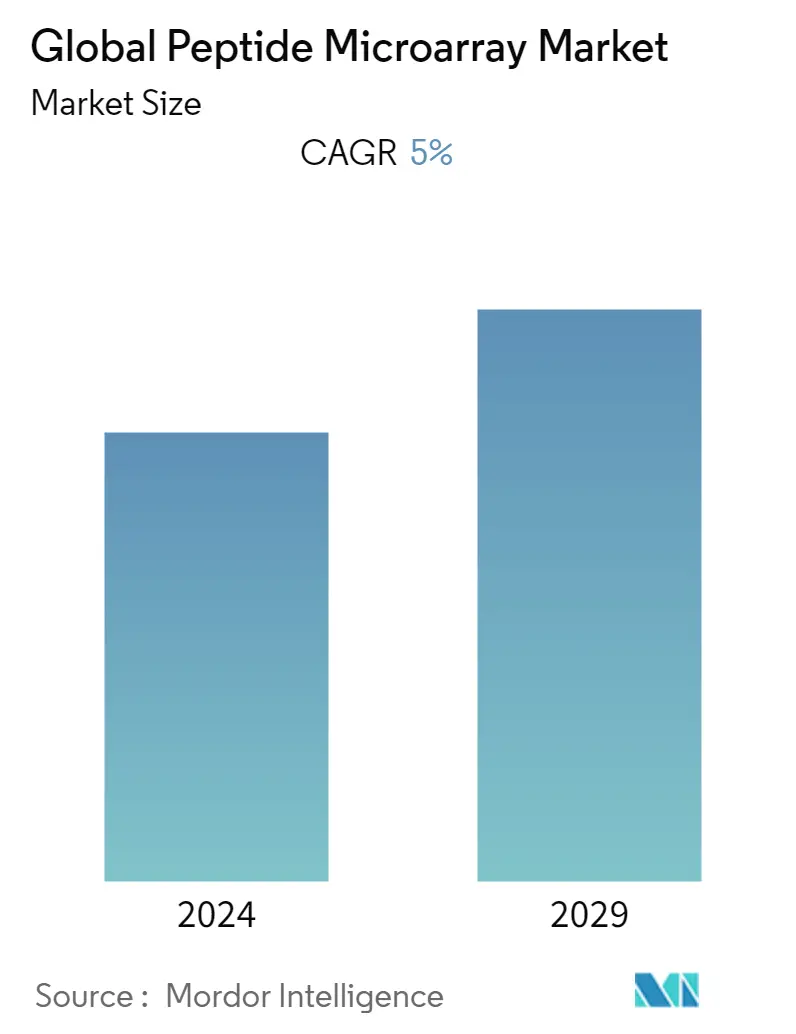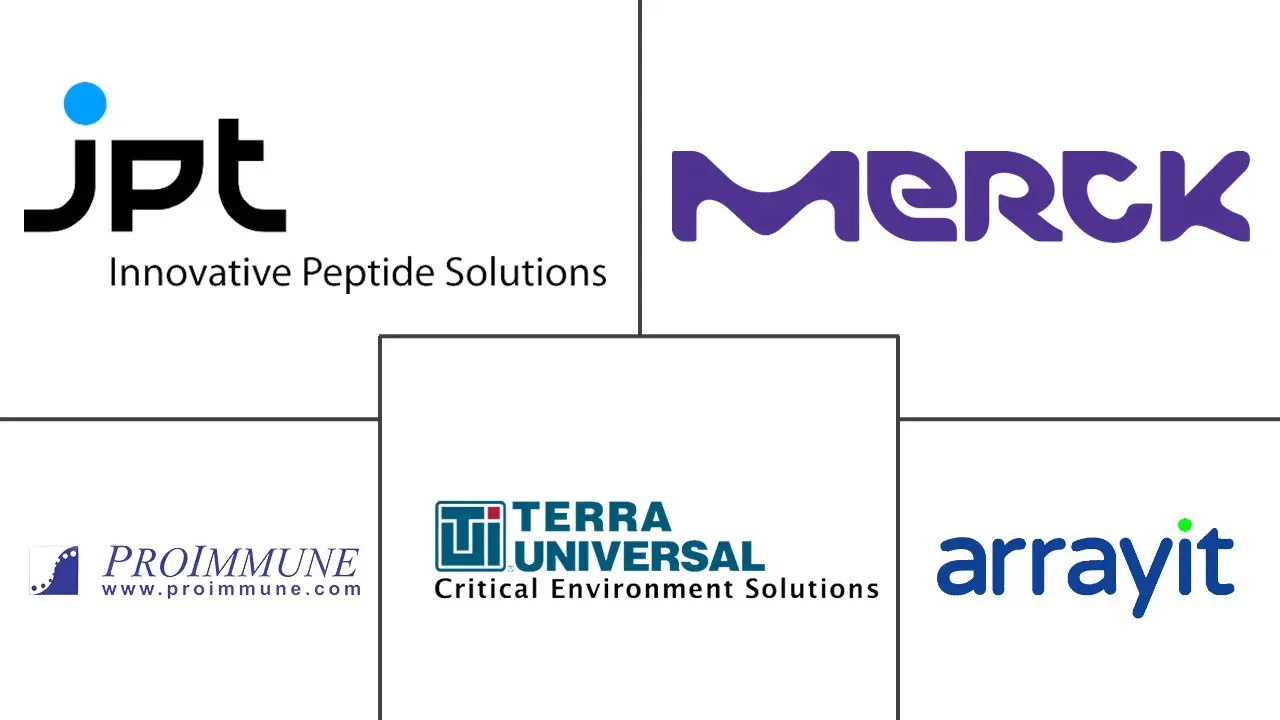Market Size of Global Peptide Microarray Industry

| Study Period | 2019 - 2029 |
| Base Year For Estimation | 2023 |
| CAGR | 5.00 % |
| Fastest Growing Market | Asia Pacific |
| Largest Market | North America |
| Market Concentration | Medium |
Major Players
*Disclaimer: Major Players sorted in no particular order |
Peptide Microarray Market Analysis
The peptide microarray market is expected to register a CAGR of 5% during the forecast period.
Peptide microarrays and protein, the emerging tools for clinical assays and proteomics, are high-throughput methods that decide the function of proteins on a large scale. The development of therapeutics required an accurate understanding of the role of the SARS-CoV-2 infection process and the progression of COVID-19. The field of proteomics is equipped with the technologies that are required to help face this challenge. In an article published in October 2020 in the Journal of Proteins and Proteomics, researchers have highlighted that developments in proteome technologies will not only accelerate progress in addressing the coronavirus pandemic but will also help to tackle the current COVID-19 crisis. A peptide microarray is used to study the binding properties of protein-protein interaction that comprises thousands of peptides in distinct patterns that will be used as a high throughput screening tool in biomedical science. For instance, in 2020, JPT peptide technologies accelerated the development of a broad collection of SARS-CoV-2 PepMix Peptide Pools that would span the most relevant antigens to address cellular immunity. JPT developed a Pan-Coronavirus RepliTope Peptide Microarray spanning the entire SARS-CoV-2 proteome and selected antigens of MERS-CoV, Common Cold Coronaviruses, and SARS-CoV for profiling humoral immune responses. Similarly in January 2020, PEPperPRINT launched the production of a proteome-wide peptide microarray covering the new coronavirus 2019-nCoV (COVID-19). It can be used to detect IgG and IgM antibody responses on the epitope level in patient sera for in-vitro diagnostic tests, diagnostics, and vaccine development. Thus, the market is exepcted to grow in the future.
Therefore the increasing burden of cancer and technological advancement are the major factors that are driving the studied market globally. Moreover, the rising prevalence of chronic diseases will further contribute to the peptide microarray market. According to the International Diabetes Federation Diabetes Atlas Tenth edition 2021, in 2021, around 537 million adults worldwide were found to have diabetes; the numbers are projected to grow to 643 million by 2030 and 783 million by 2045. The expected increase in the incidence of diabetes will increase the demand for diabetes diagnostic products and techniques, thus driving the market studied. Similarly, according to the Global Cancer Observatory (GLOBOCAN), Statistics 2020, there are 206,606,063 estimated prevalent cases of cancer in 5 years for all types of cancer in both sexes in Asia in 2020. It also reported 9,738,936 5-year prevalent cases of all types of cancer in males and about 10,867,127 cases in females. Such a high prevalence of cancer in the regions is generating the need for treatment therapies for cancer, thus driving the growth of the market studied. Furthermore, rising molecular-based diagnostics techniques demand with the advancement in the technology of diagnostic testing dominant the peptide microarray market. On February 21, 2020, the United States Food and Drug Administration updated its definition of a biologic to include chemically synthesized polypeptides greater than 40 amino acids but less than 100 amino acids in size (synthetic proteins) and synthetic peptides, 40 amino acids or less. Thus, the abovementioned factors are expected to increase market growth in the future.
However, reimbursement issues are expected to hinder the market growth.
Peptide Microarray Industry Segmentation
As per the scope of the report, peptide microarrays are a powerful technology in the proteomics and clinical assays field that traces the binding activities, histone-modifying enzymes, and function of protein linkages on a large scale. Basically, a peptide microarray is a collection of peptides on glass or membrane, or plastic chip, which is also known as a peptide chip or peptide epitope microarray. Peptide microarrays are used to study the binding properties, activity, and function of protein-protein linkage in biology, diagnostics, antibody characterization, medicine, and pharmacology. The peptide microarray market is segmented by type (instruments, reagents, and services), end-user (hospitals, pharmaceutical, and biotechnology companies, research and academic institutes), and geography (North America, Europe, Asia-Pacific, Middle-East and Africa, and South America). The market report also covers the estimated market sizes and trends for 17 different countries across the major regions globally. The report offers the values (USD million) for the above segments.
| By Type | |
| Instruments | |
| Reagents | |
| Services |
| By End User | |
| Hospitals | |
| Pharmaceutical and Biotechnology Companies | |
| Research and Academic Institutes |
| Geography | ||||||||
| ||||||||
| ||||||||
| ||||||||
| ||||||||
|
Global Peptide Microarray Market Size Summary
The peptide microarray market is poised for growth, driven by advancements in proteomics and the increasing prevalence of chronic diseases such as cancer and diabetes. Peptide microarrays serve as high-throughput screening tools in biomedical science, facilitating the study of protein-protein interactions and aiding in the development of therapeutics. The COVID-19 pandemic highlighted the importance of these technologies, as they were instrumental in understanding the virus's behavior and developing diagnostic tests and vaccines. The market is further bolstered by technological advancements in molecular-based diagnostics, which are becoming increasingly vital for early disease detection and treatment. Despite challenges like reimbursement issues, the market is expected to expand, with significant contributions from the instrument segment, which is witnessing growth due to the introduction of advanced peptide microarray products.
North America is anticipated to lead the global peptide microarray market, supported by robust healthcare infrastructure and increased healthcare expenditure. The region's high cancer burden and the demand for early diagnosis are driving the adoption of peptide microarrays. Strategic collaborations and product launches, such as those by Nimble Therapeutics and Cipla, are expected to enhance market growth by expanding the product pipeline. The market is moderately competitive, with key players like Merck KGaA, ProImmune Ltd, and JPT Peptide Technologies dominating the landscape. These companies are actively involved in research and development, partnerships, and strategic collaborations to advance peptide microarray technologies, thereby contributing to the market's expansion.
Global Peptide Microarray Market Size - Table of Contents
-
1. MARKET DYNAMICS
-
1.1 Market Overview
-
1.2 Market Drivers
-
1.2.1 Growing Burden of Chronic Diseases
-
1.2.2 Technological Advancements in Diagnostic Testing
-
-
1.3 Market Restraints
-
1.3.1 Reimbursement Issues
-
-
1.4 Porter's Five Forces Analysis
-
1.4.1 Threat of New Entrants
-
1.4.2 Bargaining Power of Buyers/Consumers
-
1.4.3 Bargaining Power of Suppliers
-
1.4.4 Threat of Substitute Products
-
1.4.5 Intensity of Competitive Rivalry
-
-
-
2. MARKET SEGMENTATION (Market Size by Value - USD million)
-
2.1 By Type
-
2.1.1 Instruments
-
2.1.2 Reagents
-
2.1.3 Services
-
-
2.2 By End User
-
2.2.1 Hospitals
-
2.2.2 Pharmaceutical and Biotechnology Companies
-
2.2.3 Research and Academic Institutes
-
-
2.3 Geography
-
2.3.1 North America
-
2.3.1.1 United States
-
2.3.1.2 Canada
-
2.3.1.3 Mexico
-
-
2.3.2 Europe
-
2.3.2.1 Germany
-
2.3.2.2 United Kingdom
-
2.3.2.3 France
-
2.3.2.4 Italy
-
2.3.2.5 Spain
-
2.3.2.6 Rest of Europe
-
-
2.3.3 Asia-Pacific
-
2.3.3.1 China
-
2.3.3.2 Japan
-
2.3.3.3 India
-
2.3.3.4 Australia
-
2.3.3.5 South Korea
-
2.3.3.6 Rest of Asia-Pacific
-
-
2.3.4 Middle East & Africa
-
2.3.4.1 GCC
-
2.3.4.2 South Africa
-
2.3.4.3 Rest of Middle East & Africa
-
-
2.3.5 South America
-
2.3.5.1 Brazil
-
2.3.5.2 Argentina
-
2.3.5.3 Rest of South America
-
-
-
Global Peptide Microarray Market Size FAQs
What is the current Global Peptide Microarray Market size?
The Global Peptide Microarray Market is projected to register a CAGR of 5% during the forecast period (2024-2029)
Who are the key players in Global Peptide Microarray Market?
Merck KGaA, ProImmune Ltd, JPT Peptide Technologies, Terra Universal Inc and Arrayit Corporation are the major companies operating in the Global Peptide Microarray Market.

